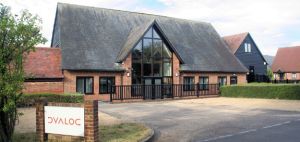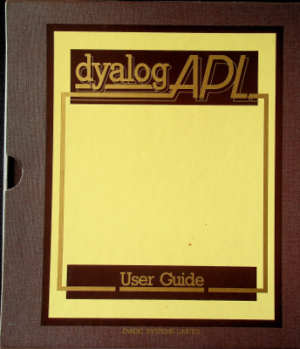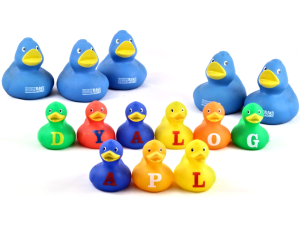Dyalog Ltd.: Difference between revisions
(→Takeover by Adaytum employees: Links to employees since 2004) |
(→Independent ownership: KPS-Adaytum connection) |
||
| Line 52: | Line 52: | ||
In 1991 [[John Daintree]] was hired to begin work on a graphical user interface, supporting the [[system function]] <source lang=apl inline>⎕WC</source>. | In 1991 [[John Daintree]] was hired to begin work on a graphical user interface, supporting the [[system function]] <source lang=apl inline>⎕WC</source>. | ||
Also in 1991, Dyadic began collaborating with George Kunzle on the PC program which would later be named KPS (Kunzle Planning System). The two lead developers of KPS were Guy Haddleton and [[Morten Kromberg]]. | Also in 1991, Dyadic began collaborating with George Kunzle on the PC program which would later be named KPS (Kunzle Planning System). The two lead developers of KPS were Guy Haddleton and [[Morten Kromberg]], and the product was soon sold to Haddleton's [[Adaytum Software]]. | ||
In 2000, [[wikipedia:Microsoft|Microsoft]] contacted Dyadic systems to ask for their participation in the project that would later be called [[.NET]]. Dyadic responded positively, and [[John Daintree]] began collaborating with Microsoft employees both on the design of .NET and on Dyalog support for it. | In 2000, [[wikipedia:Microsoft|Microsoft]] contacted Dyadic systems to ask for their participation in the project that would later be called [[.NET]]. Dyadic responded positively, and [[John Daintree]] began collaborating with Microsoft employees both on the design of .NET and on Dyalog support for it. | ||
Revision as of 16:41, 31 October 2021
Dyalog Ltd. (originally Dyadic Systems Ltd.) is the vendor for Dyalog APL and organiser of the Dyalog user meeting. Founded as an APL consultancy, Dyadic also became a reseller of IBM hardware but is now supported primarily by sales of Dyalog APL.
History
Dyadic Systems consulting
Dyadic Systems was formed in 1976 by manager and administrator Phil Goacher with sales lead Ted Hare and APL experts David Crossley, Geoff Streeter, and John Stembridge, all from the APL group at Atkins Computing, which was part of WS Atkins and a time-sharing provider.[1] Targetting large companies and especially Rank Xerox, Dyadic aimed "to establish a dominant position in a small part of the market based on a reputation for excellence" promoted by "excellent salaries and working conditions", according to its initial prospectus.[2] Because it was not tied to a particular vendor, the company's employees gained experience with many APL dialects. Of these, the most used were SHARP APL, APL*PLUS, and Sigma APL, but Dyadic also worked with APLs from IBM, DEC, Honeywell, Burroughs, and others, and some non-APL languages. IBM's promotion of VS APL as a platform became another source of demand for APL consulting.[3]
During this period Dyadic hired Pauline Brand, and Pete Donnelly of W. H. Smith.[4]
Dyalog APL
The market for personal computers was quickly growing at the beginning of the 1980s. As a consulting rather than a timesharing business, Dyadic was not tied to the mainframe model, but was hindered by the small number of APL implementations for PC. In 1981, the company met with Zilog UK regarding the upcoming System 8000, based on the Z8000 processor. Zilog wanted an APL for the Z8000 because of a requirement set by the Swedish Ministry of Defence for Unix suppliers.
Dyalog (Europe) Ltd. was registered for this purpose in 1981. The new name blended those of the two collaborators, as mentioned in the press release:
This company is DYALOG (EUROPE) LIMITED, the name Dyalog being a hybrid derived from Dyadic and Zilog.
The “Marketing Strategy” paper read:
Our plan is to develop a low-price:
- Industry-standard APL interpreter (Sharp look-alike but more comprehensive)
- Running on an industry-standard 16-bit chip (Z8000)
- Under an industry-standard operating system (UNIX)
Zilog provided a dedicated Z8000 minicomputer and development facilities for the Dyalog language. Dyadic hired John Scholes (another Atkins employee, who had left to work as a developer on an APL implementation for the ICL 2900) as designer and chief programmer for the project. Geoff Streeter and David Crossley joined Scholes as Dyalog implementors.
The choice to implement Dyalog in C on a UNIX system would later enable Dyalog APL to be ported to many other systems. The choice to make Dyalog a nested APL like NARS and the in-process APL2 would also have a major effect on Dyalog's development as a company.
Dyalog APL was released at the 1983 APL Conference in Washington, D.C., a venue it shared with MicroAPL's APL.68000 and STSC's APL*PLUS/PC. Initial sales were slow due to the obscurity at the time of the nested array model, Unix operating system, and Zilog system in addition to Dyalog APL's poor performance relative to other APLs exhibited.
Purchase by Lynwood
In October 1983, Dyadic Systems, suffering both from decreasing consulting profits and poor sales of Dyalog APL, was purchased by computer terminal manufacturer Lynwood Scientific Developments Limited. Dyadic was allowed to maintain Dyalog APL under Lynwood for the next seven years despite continuous losses. Lynwood was acquired in 1988 by Hunting plc.
During this period Dyalog APL was ported to a large number of UNIX systems. While sales remained low, Simcorp began working with Dyalog in 1985. Simcorp remains a major user of Dyalog APL.
In 1986, Dyadic began to sell UNIX hardware to be used with their APL implementation, including the IBM 6150 in July of that year. Pauline Brand directed Dyadic's hardware division, a position she would maintain until its sale in 2002. British Airways was one client and eventually expanded its use of UNIX along with its relationship with Dyadic. In 1987 Dyalog APL for the 6150 became an IBM Vendor Logo product available directly from IBM, despite being in direct competition with IBM's APL2.
Dyadic hired Andy Cooke as Sales Manager and Andy Shiers as Customer Support Analyst in July 1987.
Independent ownership
In March 1990, John Scholes, Pauline Brand, and Peter Donnelly bought Dyadic Systems from Hunting plc. The purchase followed an informal offer by STSC in 1989, which had been rejected. Over the decade, the majority of Dyadic's profits were generated by hardware sales under Brand while Dyalog APL gained market share but failed to show comparable profits.
Dyadic added support for Dyalog APL on the Sun operating system and IBM's RS/6000 in 1990, which led to a growing user base in New York consisting of financial companies.
In 1991 John Daintree was hired to begin work on a graphical user interface, supporting the system function ⎕WC.
Also in 1991, Dyadic began collaborating with George Kunzle on the PC program which would later be named KPS (Kunzle Planning System). The two lead developers of KPS were Guy Haddleton and Morten Kromberg, and the product was soon sold to Haddleton's Adaytum Software.
In 2000, Microsoft contacted Dyadic systems to ask for their participation in the project that would later be called .NET. Dyadic responded positively, and John Daintree began collaborating with Microsoft employees both on the design of .NET and on Dyalog support for it.
Dyalog Limited
In 2002 the software side of Dyadic Systems separated from the company, taking its current name Dyalog Ltd., and in 2003, the remainder of Dyadic Systems, then purely a hardware vendor, was sold to Syan Ltd. Following the separation, Dyalog had only five employees: John Scholes, Peter Donnelly, John Daintree, Geoff Streeter, and support staff Vincent Chan. The company maintained consistent profits despite its small size.
In 2003, on news that the APL conference would no longer be held yearly, Dyalog held the first of its user meetings.[5]
Takeover by Adaytum employees
In 2004, Donnelly approached Morten Kromberg and Gitte Christensen of Adaytum Software to ask them to take over management of the company. With backing from Simcorp and APL Italiana, the pair began leadership on 7 April 2005.[6]
In March 2007, Dyalog's growing team moved to its current office in Bramley, Hampshire. The office, a restored barn including original oak beams, was chosen in part for its large windows with a view of a nearby wheat field.[7]
Employees hired during the period of Insight management include Dan Baronet, Roger Hui, Jay Foad, Brian Becker, Adám Brudzewsky, and Aaron Hsu. Nick Nickolov and Marshall Lochbaum worked at the company briefly, for two and three years respectively.
The Dyalog duck
While it is not an official logo, Dyalog is often associated with the rubber duck, and uses it to demonstrate graphical applications. Dyalog's office is home to over a hundred rubber ducks. Dyalog explains some of their history with ducks in "The Dyalog Duck".
The tradition began in 1989 when Peter Donnelly demonstrated the use of a graphics library for the newly supported DOS/386. Various members of the company continued to use ducks for similar purposes, with Donnelly and John Daintree the most prolific in this usage.
Events
Dyalog arranges several recurring events (for dates see Dyalog's Event calendar):
External links
Websites
Social media
Functional programming conferences
In recent years, Dyalog has continuously presented at the following functional programming conferences:
References
- ↑ Geoff Streeter. "Phil Goacher (05-11-40 – 09-03-18)". Dyalog blog. 2018-03-29.
- ↑ "Dyadic Systems Limited: A Prospective Computing Consultancy". 1976.
- ↑ Stephen Taylor. "How we got here". Vector journal Volume 23 special supplement "Dyalog at 25". 2008-09.
- ↑ Peter Donnelly. "Dyalog APL: A Personal History".
- ↑ Adrian Smith. "Dyalog APL 2003 Conference". Vector journal volume 20 issue 2. 2003-10.
- ↑ "New Management at Dyalog Ltd.". Vector journal Volume 21 No. 2. 2005-02.
- ↑ News from sustaining members: Country Life. Vector journal volume 23 issue 1. 2008-01.
| APL development [edit] | |
|---|---|
| Interface | Session ∙ Typing glyphs (on Linux) ∙ Fonts ∙ Text editors |
| Publications | Introductions ∙ Learning resources ∙ Simple examples ∙ Advanced examples ∙ Mnemonics ∙ ISO 8485:1989 ∙ ISO/IEC 13751:2001 ∙ A Dictionary of APL ∙ Case studies ∙ Documentation suites ∙ Books ∙ Papers ∙ Videos ∙ APL Quote Quad ∙ Vector journal ∙ Terminology (Chinese, German) ∙ Neural networks ∙ Error trapping with Dyalog APL (in forms) |
| Sharing code | Backwards compatibility ∙ APLcart ∙ APLTree ∙ APL-Cation ∙ Dfns workspace ∙ Tatin ∙ Cider |
| Implementation | Resources ∙ Open-source ∙ Magic function ∙ Performance ∙ APL hardware |
| Developers | Timeline of corporations ∙ APL2000 ∙ Dyalog ∙ IBM ∙ IPSA ∙ STSC |


